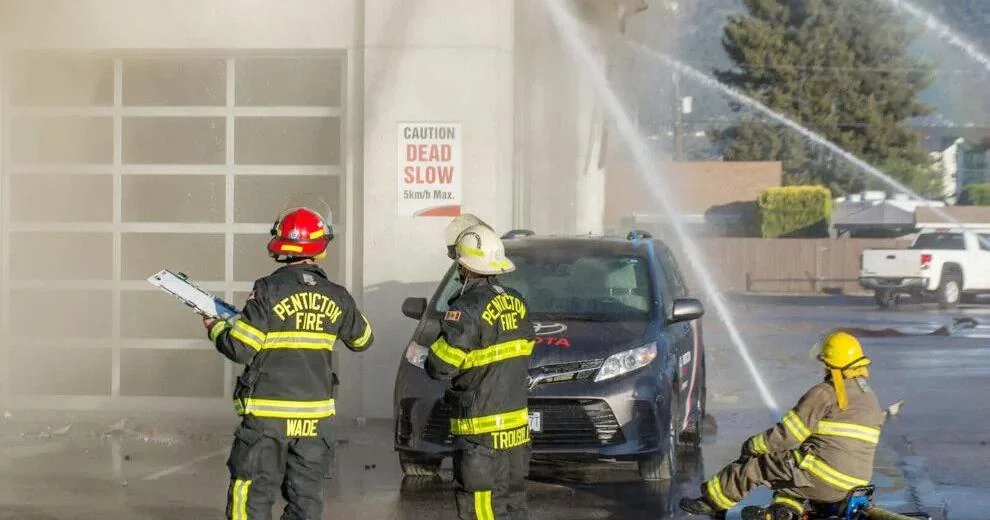
Table of Contents
On April 28, 2017, a tragic workplace accident occurred at Skaha Ford in Penticton, British Columbia, resulting in the death of an employee. The incident, which involved a man being pinned between two vehicles, shocked both the local community and the automobile industry. Emergency responders were called to the scene at approximately 11:40 a.m., marking the beginning of an intense and heart-wrenching rescue operation. This article aims to provide a detailed, comprehensive account of the tragic accident, the subsequent investigations, and the broader implications for workplace safety in the automobile dealership industry.
The Incident: A Fatal Workplace Accident at Skaha Ford
At around 11:40 a.m. on that fateful Friday, emergency services were notified about a distressing situation at Skaha Ford, a well-known automobile dealership in Penticton. According to reports, the male employee, believed to be in his 30s, had become trapped between two vehicles, a common occurrence in environments where heavy machinery and vehicles are handled daily.
It is not entirely clear how the employee was caught, but workers who were present on-site at the time of the accident acted quickly. They were able to free the victim from the dangerous position between the cars. Despite their efforts, which included performing CPR, the employee’s condition remained critical. Paramedics arrived at the scene shortly after and took the victim to the hospital, but sadly, he could not be revived.
Emergency Response: Quick Action Amidst the Tragedy
The response to the incident was swift, with colleagues of the trapped employee taking immediate action. Their quick thinking likely played a crucial role in attempting to save the man’s life. CPR was administered as soon as he was freed from between the vehicles, a standard life-saving procedure that may have kept him alive long enough for paramedics to take over.
However, despite the best efforts of everyone involved, the man’s injuries were too severe, and he passed away shortly thereafter in the hospital. The swift arrival of emergency responders ensured that the incident was dealt with in a timely manner, although the tragic outcome could not be avoided.
Investigations: WorkSafeBC and Coroner’s Role in Understanding the Accident
Following the accident, several investigations were initiated to understand the exact cause of the incident and to determine any potential violations of safety protocols. WorkSafeBC, the provincial body responsible for workplace health and safety, launched a full investigation into the circumstances surrounding the fatality. This process involved interviewing witnesses, reviewing safety protocols, and analyzing the site of the accident to understand what went wrong and to prevent similar incidents in the future.
In addition to the WorkSafeBC investigation, the coroner’s office also took charge of determining the cause of death. The coroner’s investigation focused on medical factors that may have contributed to the tragic outcome and looked into the specific injuries that led to the fatality.
Although RCMP were involved in the investigation, they confirmed that no further details about the incident would be released. Their role primarily focused on ensuring the proper procedures were followed and assisting with the overall investigation.
Safety Protocols in the Automobile Dealership Industry
This tragedy underscores the importance of stringent workplace safety measures in environments like automobile dealerships, where workers often interact with heavy machinery and vehicles. The nature of the work in car dealerships involves tasks that carry inherent risks, such as vehicle maintenance, repairs, and test driving. In many cases, these activities are performed with little margin for error, making proper safety protocols vital for preventing accidents.
Workplace safety measures in the automobile dealership industry typically include training employees on safe practices for handling vehicles, ensuring proper equipment is used for lifting and moving cars, and requiring routine safety checks of equipment and machinery. However, as this tragic incident demonstrates, even with the best safety measures in place, accidents can still occur, often with devastating consequences.
Preventing Future Incidents: The Importance of Workplace Safety Culture
The fatal workplace accident at Skaha Ford serves as a stark reminder of the need for a robust workplace safety culture in all industries, especially those involving heavy equipment. A safety culture involves not only having safety protocols in place but also fostering an environment where workers feel comfortable reporting unsafe conditions, receiving ongoing training, and participating in safety drills.
Dealerships and similar businesses must prioritize regular safety audits and invest in state-of-the-art equipment that reduces the risk of accidents. Additionally, management should encourage open communication about potential hazards and ensure that workers feel empowered to speak up without fear of retaliation.
Mental Health and Support for Affected Workers
In the wake of such a traumatic event, the mental well-being of the employees and others who witnessed the accident must also be addressed. Workplace tragedies can have profound psychological effects on those who were involved or who witnessed the event firsthand. It is essential that employers provide support for their employees, including access to counseling services and mental health resources, to help them cope with the emotional toll of such an incident.
Employers should also implement post-accident recovery programs to help workers process the event and reintegrate into the workplace. These programs should be tailored to meet the needs of those affected, and can play a critical role in ensuring long-term employee wellness.
Conclusion
The tragic accident at Skaha Ford serves as a powerful reminder of the critical importance of workplace safety in the automobile dealership industry. It highlights the need for thorough safety protocols, employee training, and a culture that prioritizes the well-being of workers. By learning from incidents like these, the industry can take steps to mitigate risks and prevent future tragedies, ensuring that all employees return home safely at the end of each workday. Through a combination of better safety practices, improved equipment, and ongoing worker support, businesses can work toward creating safer, more resilient workplaces for everyone involved.
